中西方饮食文化差异-英语
- 格式:ppt
- 大小:11.44 MB
- 文档页数:21
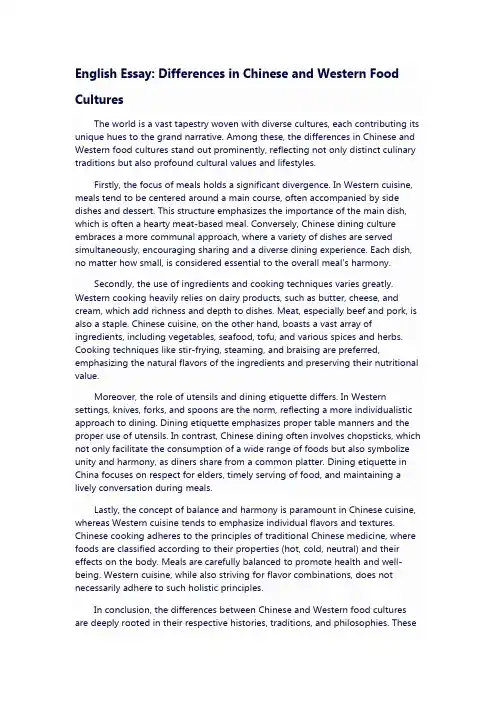
English Essay: Differences in Chinese and Western Food CulturesThe world is a vast tapestry woven with diverse cultures, each contributing its unique hues to the grand narrative. Among these, the differences in Chinese and Western food cultures stand out prominently, reflecting not only distinct culinary traditions but also profound cultural values and lifestyles.Firstly, the focus of meals holds a significant divergence. In Western cuisine, meals tend to be centered around a main course, often accompanied by side dishes and dessert. This structure emphasizes the importance of the main dish, which is often a hearty meat-based meal. Conversely, Chinese dining culture embraces a more communal approach, where a variety of dishes are served simultaneously, encouraging sharing and a diverse dining experience. Each dish, no matter how small, is considered essential to the overall meal's harmony.Secondly, the use of ingredients and cooking techniques varies greatly. Western cooking heavily relies on dairy products, such as butter, cheese, and cream, which add richness and depth to dishes. Meat, especially beef and pork, is also a staple. Chinese cuisine, on the other hand, boasts a vast array of ingredients, including vegetables, seafood, tofu, and various spices and herbs. Cooking techniques like stir-frying, steaming, and braising are preferred, emphasizing the natural flavors of the ingredients and preserving their nutritional value.Moreover, the role of utensils and dining etiquette differs. In Western settings, knives, forks, and spoons are the norm, reflecting a more individualistic approach to dining. Dining etiquette emphasizes proper table manners and the proper use of utensils. In contrast, Chinese dining often involves chopsticks, which not only facilitate the consumption of a wide range of foods but also symbolize unity and harmony, as diners share from a common platter. Dining etiquette in China focuses on respect for elders, timely serving of food, and maintaining a lively conversation during meals.Lastly, the concept of balance and harmony is paramount in Chinese cuisine, whereas Western cuisine tends to emphasize individual flavors and textures. Chinese cooking adheres to the principles of traditional Chinese medicine, where foods are classified according to their properties (hot, cold, neutral) and their effects on the body. Meals are carefully balanced to promote health and well-being. Western cuisine, while also striving for flavor combinations, does not necessarily adhere to such holistic principles.In conclusion, the differences between Chinese and Western food cultures are deeply rooted in their respective histories, traditions, and philosophies. Thesevariations not only enrich our dining experiences but also offer insights into the diverse ways in which cultures around the world approach food, nutrition, and social interaction.中文翻译:中西方饮食文化的差异世界是一幅由多元文化交织而成的壮丽画卷,每种文化都为这幅画卷增添了独特的色彩。
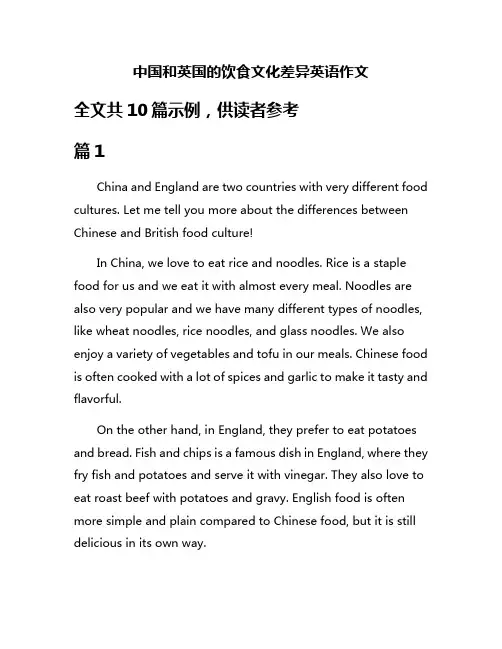
中国和英国的饮食文化差异英语作文全文共10篇示例,供读者参考篇1China and England are two countries with very different food cultures. Let me tell you more about the differences between Chinese and British food culture!In China, we love to eat rice and noodles. Rice is a staple food for us and we eat it with almost every meal. Noodles are also very popular and we have many different types of noodles, like wheat noodles, rice noodles, and glass noodles. We also enjoy a variety of vegetables and tofu in our meals. Chinese food is often cooked with a lot of spices and garlic to make it tasty and flavorful.On the other hand, in England, they prefer to eat potatoes and bread. Fish and chips is a famous dish in England, where they fry fish and potatoes and serve it with vinegar. They also love to eat roast beef with potatoes and gravy. English food is often more simple and plain compared to Chinese food, but it is still delicious in its own way.Another difference is that in China, we like to eat our meals with chopsticks, while in England, they use fork and knife. It can be a bit tricky to use chopsticks at first, but once you get the hang of it, it's really fun!Overall, both Chinese and British food cultures have their own unique flavors and traditions. It's interesting to see how different countries have different ways of preparing and enjoying food. Whether you prefer Chinese noodles or British fish and chips, there's something for everyone to enjoy!篇2China and Britain are two countries with very different food cultures. Let's take a look at some of the differences between Chinese and British food cultures.In China, people eat a lot of rice. Rice is a staple food in China, and it is served with almost every meal. In Britain, on the other hand, people eat a lot of bread. Bread is a staple food in Britain, and it is served with almost every meal.In China, people eat a lot of vegetables. Vegetables are a big part of Chinese cuisine, and they are usually stir-fried or steamed. In Britain, people eat a lot of meat. Meat is a big part of British cuisine, and it is usually roasted or grilled.In China, people eat a lot of noodles. Noodles are a popular dish in China, and they are served in many different ways. In Britain, people eat a lot of potatoes. Potatoes are a popular dish in Britain, and they are served boiled, mashed, or fried.In China, people drink a lot of tea. Tea is a big part of Chinese culture, and it is served with almost every meal. In Britain, people drink a lot of tea too, but they also drink a lot of coffee. Coffee is a big part of British culture, and it is served with almost every meal.Overall, the food cultures of China and Britain are very different. Each country has its own unique dishes and traditions, which make eating in China and Britain a truly special experience.篇3Oh, hi there! Today I'm gonna talk about the differences between Chinese and British food culture. It's gonna be super interesting, trust me!So, in China, food is like super important. We have so many delicious dishes like dumplings, noodles, and rice. We love to eat together with our family and friends, and we always make sure there's enough food for everyone. And we use chopsticks to eat, which is totally cool!But in Britain, they have different food culture. They love their tea and scones, and fish and chips. They also have this thing called a roast dinner, where they eat roast meat like chicken or beef with potatoes and veggies. And they like to have a cup of tea with milk in the afternoon, which is kinda weird but also kinda nice.Another big difference is the way we eat. In China, we like to eat our food hot and fresh, and we use a lot of spices and sauces to make it tasty. But in Britain, they prefer their food more plain and simple, without too many seasonings. They also eat a lot of bread and cheese, which we don't really have in China.Overall, both Chinese and British food cultures are super cool in their own way. It's really interesting to see how different countries have their own unique food traditions. I hope you learned something new today! Thanks for reading, bye!篇4Oh, hi everyone! Today I want to talk about the differences between Chinese and British food culture! It's super interesting, trust me!First of all, let's talk about breakfast. In China, we love to eat congee, fried dough sticks, and steamed buns for breakfast. It'sso yummy! But in the UK, they usually have cereal, toast, and maybe some eggs and bacon. It's quite different, right?Next, let's talk about tea time. In China, we like to have tea and maybe some snacks like dumplings or mooncakes. But in the UK, they have afternoon tea with scones, sandwiches, and cakes. It's so fancy!And for dinner, Chinese people usually eat rice or noodles with veggies and meat. We love to share dishes with our family and friends. But in the UK, they might have roast beef with potatoes and gravy. It's a big meal!Oh, and don't forget about desserts! In China, we have sweet treats like red bean buns and mango pudding. But in the UK, they love their puddings like sticky toffee pudding and apple crumble. It's so tasty!So, you see, there are lots of differences between Chinese and British food culture. But both countries have delicious food that you should try! Maybe you can have a Chinese takeaway one day and then try some traditional British dishes the next. It's a tasty adventure!That's all for now, see you next time! Bye bye!篇5Hello everyone! Today I'm going to talk about the differences between Chinese and British food culture.First of all, let's talk about Chinese food. Chinese people love to eat rice, noodles, and lots of vegetables. We also like to eat a lot of different types of meat, like pork, beef, and chicken. Some popular Chinese dishes include dumplings, fried rice, and hot pot. We also have a tradition of drinking tea with our meals.On the other hand, British food is quite different. British people love to eat things like fish and chips, roast beef with Yorkshire pudding, and bangers and mash. They also love to eat desserts like scones with clotted cream and jam, and sticky toffee pudding. British people often drink tea with milk, or coffee with their meals.Another big difference between Chinese and British food culture is the way meals are served. In China, we usually have a family-style meal, where everyone shares dishes. In Britain, meals are served in courses, starting with a starter, then a main course, and finally dessert.Overall, both Chinese and British food cultures are unique and delicious in their own ways. It's fun to try new foods from different cultures and see how they differ from the food we'reused to. I hope you enjoyed learning about these differences! Thanks for reading!篇6Hey guys! Today, let's talk about the differences between Chinese and British food culture. Are you ready? Let's go!First of all, let's talk about Chinese food. In China, people love to eat rice and noodles. We also eat a lot of vegetables and fruits. Chinese food is very diverse and each region has its own special dishes. Some famous Chinese dishes are dumplings, Kung Pao chicken, and Peking duck. Yum!On the other hand, British food is quite different. In Britain, people eat a lot of meat and potatoes. Some popular British dishes are fish and chips, roast beef, and shepherd's pie. In Britain, people also love to drink tea. Afternoon tea is a very popular tradition in Britain.Another difference between Chinese and British food culture is the way meals are served. In China, meals are servedfamily-style, which means that everyone shares dishes. In Britain, meals are served individually, with each person getting their own plate of food.Overall, Chinese and British food cultures are quite different but both are delicious in their own way. So next time you have the chance, try some Chinese and British food and see which one you like better. Bon appétit!篇7Hey guys! Today, let's talk about the differences between Chinese and British food culture. It's super interesting, so listen up!First of all, let's talk about Chinese food. In China, we love to eat rice, noodles, and dumplings. And oh my goodness, the flavors are out of this world! We have so many different dishes with yummy sauces and spices. Plus, we eat with chopsticks, which is so fun!But in Britain, they love their fish and chips. Can you believe it? They fry fish and potatoes and eat it with vinegar. It's totally different from our food, but I bet it's tasty too. And they use knives and forks to eat, not chopsticks like us.Another big difference is the way we eat together. In China, we love to share dishes with our family and friends. It's all about sharing and caring. But in Britain, everyone has their own plate of food. They don't share like we do.And don't even get me started on dessert! In China, we have sweet buns, rice cakes, and fruit for dessert. But in Britain, they love their puddings like apple crumble and custard. It's so different from what we eat, but I bet it's delicious.Overall, Chinese and British food cultures are so different, but both are amazing in their own way. So let's keep enjoying all the tasty food from around the world!That's all for today, guys. I hope you learned something new about Chinese and British food culture. Bye!篇8China and the UK are two countries with very different food cultures. In China, we love to eat rice, noodles, and dumplings. These are some of our staple foods that we eat almost every day. We also enjoy dishes like Kung Pao chicken, Peking duck, and hot pot. These dishes are full of flavor and very delicious.In the UK, people eat a lot of different foods than we do in China. They love to eat fish and chips, roast beef, and shepherd's pie. They also enjoy desserts like scones, Victoria sponge cake, and trifle. The food in the UK is quite different from what we are used to, but it is still very tasty.One big difference between Chinese and British food culture is the way we eat our meals. In China, we like to eat family-style, where everyone shares dishes from the middle of the table. This creates a sense of community and togetherness. In the UK, people tend to eat their own individual meal without sharing. This can sometimes feel a bit lonely, but it is just a different way of eating.Another difference is the use of spices and seasonings. Chinese food is often very flavorful and spicy, with lots of garlic, ginger, and soy sauce. British food, on the other hand, is more subtle in its flavors, with a focus on herbs like parsley and thyme. Some people in the UK find Chinese food too spicy, while some Chinese people may find British food a bit bland.Overall, both Chinese and British food cultures have their own unique flavors and traditions. It is interesting to learn about the differences and similarities between the two, and to try new foods from different cultures. Food is a big part of our lives, and it is a great way to connect with people from around the world. Let's keep enjoying delicious food together!篇9China and Britain have very different food cultures. Let me tell you about the differences!First of all, in China, we love to eat rice as our staple food. Rice is the most important part of our meals. We also eat a lot of noodles, dumplings, and steamed buns. These foods are delicious and very filling. In Britain, they eat a lot of bread and potatoes. They love to have sandwiches for lunch and potatoes with their meals. They also enjoy fish and chips, which is a popular dish in Britain.Another big difference is the way we eat our meals. In China, we use chopsticks to eat our food. Chopsticks are long, thin sticks that we use to pick up our food. In Britain, they use knives and forks to eat. They cut their food into small pieces and then use their forks to eat. It's very different from how we eat in China!In China, we also have a lot of different types of tea that we drink with our meals. We have green tea, black tea, oolong tea, and many other varieties. In Britain, they drink a lot of black tea with milk and sugar. They also love to have afternoon tea with sandwiches and scones.Overall, China and Britain have very different food cultures. But both countries have delicious and unique dishes that areloved by their people. It's fun to learn about the food traditions of different countries!篇10Chinese and British food cultures are different in many ways. Let's explore these differences and see how they make each country's food unique!In China, we love noodles, dumplings, and rice. Noodles can be found in all shapes and sizes, and we like to slurp them up quickly. Dumplings are stuffed with meat or vegetables and are boiled or fried. They are so yummy! Rice is a staple food in China, and we eat it with almost every meal.On the other hand, in Britain, they love their fish and chips. Fish is usually battered and deep-fried, served with crispy fries. It's a popular dish that you can find at many pubs and restaurants. They also enjoy their pies, like meat pies or shepherd's pies. They are hearty and delicious!Chinese people enjoy tea with their meals, while British people prefer a cup of black tea or coffee. Both countries have their own unique desserts too. In China, we have sweet red bean soup or tangyuan (glutinous rice balls). In Britain, they love their scones with clotted cream and jam, or sticky toffee pudding.Overall, both Chinese and British food cultures have their own specialties and flavors that make them special. It's fun to try new foods from different countries and see how they can be so different yet so delicious! Let's celebrate the diversity in food cultures and enjoy the tasty dishes each country has to offer. Yum yum!。
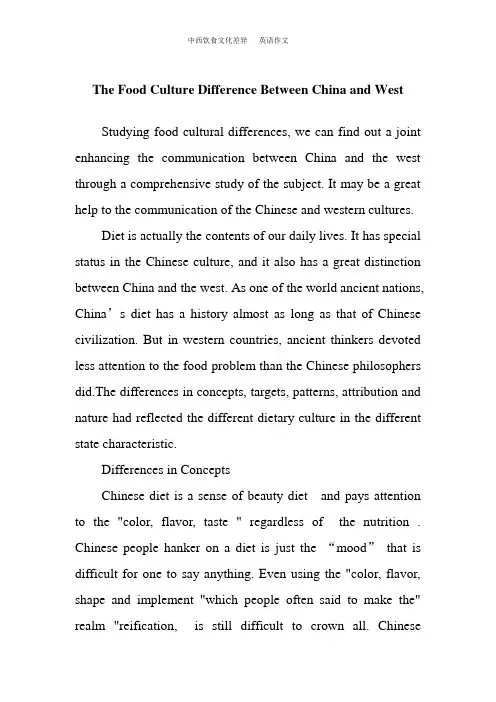
The Food Culture Difference Between China and WestStudying food cultural differences, we can find out a joint enhancing the communication between China and the west through a comprehensive study of the subject. It may be a great help to the communication of the Chinese and western cultures.Diet is actually the contents of our daily lives. It has special status in the Chinese culture, and it also has a great distinction between China and the west. As one of the world ancient nations, China’s diet has a history almost as long as that of Chinese civilization. But in western countries, ancient thinkers devoted less attention to the food problem than the Chinese philosophers did.The differences in concepts, targets, patterns, attribution and nature had reflected the different dietary culture in the different state characteristic.Differences in ConceptsChinese diet is a sense of beauty diet and pays attention to the "color, flavor, taste " regardless of the nutrition . Chinese people hanker on a diet is just the “mood”that is difficult for one to say anything. Even using the "color, flavor, shape and implement "which people often said to make the" realm "reification, is still difficult to crown all. Chinesecooking method is to reconcile, and the ultimate goal is to reconcile out of a beautiful taste.Western diet is a rational concept, regardless of the color of food, incense, flavor and shape, but nutrition must be assured.In celebration, it stresses tableware, stresses the staple, stresses the servings, and stresses the color and shape mix of raw materials. But no matter how luxurious the grade is; from Los Angeles to New York, only one taste of steak, it is no art to speak of. As dishes, things will not be mixed up. The chicken is chicken; steak is steak, even in groups, which are also conducted in a shallow dish. Color is on clear, but the tastes of the various materials are separated, not to reconcile, and the entire flavor is also simple and clear.Differences in targetsIn China ,all diet cannot be done without vegetables. The word "dish" is for the sound, and it always has something to do with the plants . In fact, the Chinese dishes, vegetable dish is usual food. Meat dish entered the normal diet only on holidays or higher living standards, so since ancient times, and there was a saying of "fresh vegetables". Chinese people consider the vegetables as the main dish; it has inextricably linked with the advocacy of Buddhists. The Chinese character is called the plantcharacter.Westerners do not seem to have such a good habit. They uphold a cultural origin of nomadic, seafaring nation. Living mainly by fishing and hunting, collection and planting are just the complement. There are more meat dishes in their lives. Feeding, clothing, and using are taken from the animals, and even Western medicine is derived from animals. When the westerners introduce the diet characteristics of their countries, they always feel that their diet is more reasonable on the mix of nutrition than China.The Western character is called animal character.Differences in Dietary PatternsIn China, a celebration, no matter what, there will be only one form, as sitting together, sharing one feast. Banquet uses round table, which has created a unity of form, which is courtesy, comity atmosphere. Cates are in the center of the table. It is the objects for people to appreciate and taste, and it is also an intermediate of communication. People toast each other and share the vegetables, which reflect the mutual respect between people in the face of the good things, also show the virtues of comity.Although from the health point of view, this approach has obvious deficiencies.In West ,buffet dinner is popular. This shows a western personality and self-respect. This method is to display all food, and everybody is picking not fixed in his or her places to eat. They walk freely. This approach would provide the emotional interaction between individuals; they never need to put every word on the table. This also shows a western personality and self-respect. However, all the eating without jamming lacks the real affective tone like the Chinese people. The buffet has broken such pattern which shows harmony and unity.Differences in the NatureIn China, "The game is work, and the work is of a game”. Such life manner is also emerged in diet. A baker sells bread in the street, he likes using the rolling pole to beat the chopping board rhythmically when they knead flour. When the cooks fry a dish, even beating scoop, they also care the sense of rhythm during cooking. These would not work for any conveniences, but it increases the interests of workers. Only in such an atmosphere work will be meaningful, and it will have more creativity and artistry of Chinese cuisine.In the west, people do the duplication of pipeline operations, and implement piece-wage system, so the paces of their lives are so fast. People fall under the mechanical methodeither intentionally or unintentionally, and believe that "Work is work, and game is game." Mechanical lives led to oneness of diet or a single blind about diet, and eat beefsteak and potatoes every day. Monotonous diet is the same as work, for which the purposes is to fulfill the "incident", naturally with no interests, and all these have no word in terms of taste.There still exist various differences between Chinese and western dietary cultures. But with the development of cultural communication between China and the west, along with the strengthening of communication between China and the west, China has imported various kinds of western food, known as the "KFC" "DICOS", "McDonald". This marks a new western dietary culture exchanges and infiltration. We believe that with the development of society, the cultural differences between Chinese and western dietary will no longer be the difference.。
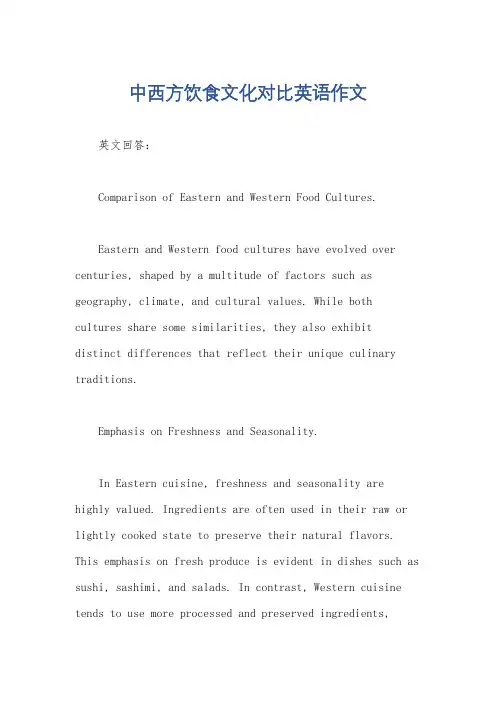
中西方饮食文化对比英语作文英文回答:Comparison of Eastern and Western Food Cultures.Eastern and Western food cultures have evolved over centuries, shaped by a multitude of factors such as geography, climate, and cultural values. While bothcultures share some similarities, they also exhibitdistinct differences that reflect their unique culinary traditions.Emphasis on Freshness and Seasonality.In Eastern cuisine, freshness and seasonality are highly valued. Ingredients are often used in their raw or lightly cooked state to preserve their natural flavors. This emphasis on fresh produce is evident in dishes such as sushi, sashimi, and salads. In contrast, Western cuisine tends to use more processed and preserved ingredients,allowing for greater flexibility in preparation and storage.Balance and Harmony.Eastern cuisine is characterized by a focus on balance and harmony. Dishes often combine a variety of flavors and textures, such as sweet, sour, salty, and bitter. This balance is achieved through the careful selection and combination of ingredients, as well as the use of cooking techniques that preserve the natural flavors of each ingredient. Western cuisine, on the other hand, often emphasizes a single dominant flavor, such as saltiness or sweetness, and may use more intense seasonings and sauces.Communal Dining.In Eastern cultures, dining is often a communal experience, with meals shared among family and friends. Dishes are typically served in large portions and placed in the center of the table, allowing everyone to partake. This communal aspect fosters a sense of togetherness and sharing. Western cuisine, while not always communal, often involvessmaller portion sizes and individual plates, reflecting a more individualized approach to dining.Influence of Religion.Religion has played a significant role in shaping both Eastern and Western food cultures. In the East, Buddhismand Taoism have influenced the development of vegetarianand vegan diets. Hinduism has also introduced a wide rangeof spices and herbs to Indian cuisine. In the West, Christianity has influenced fasting practices and dietary restrictions during Lent and other religious holidays.Availability of Ingredients.The availability of ingredients has also shaped the development of Eastern and Western food cultures. Eastern cuisine has long been influenced by the abundance of rice, vegetables, and seafood in Asia. Western cuisine, on the other hand, has historically relied on wheat, meat, anddairy products, which were more readily available in Europe.Impact of Globalization.Globalization has led to increased interaction and exchange between Eastern and Western food cultures. Ingredients, dishes, and culinary techniques from both cultures have become more widely available and incorporated into new and innovative cuisines. This has contributed to a greater appreciation and understanding of both Eastern and Western culinary traditions.中文回答:东西方饮食文化对比。
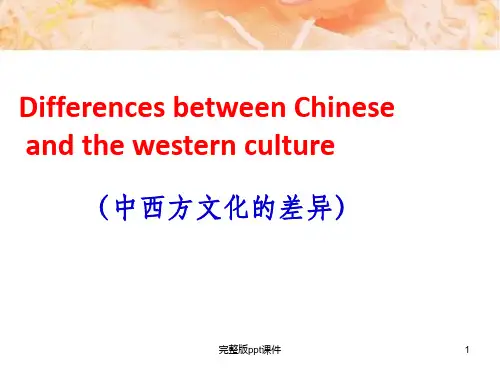
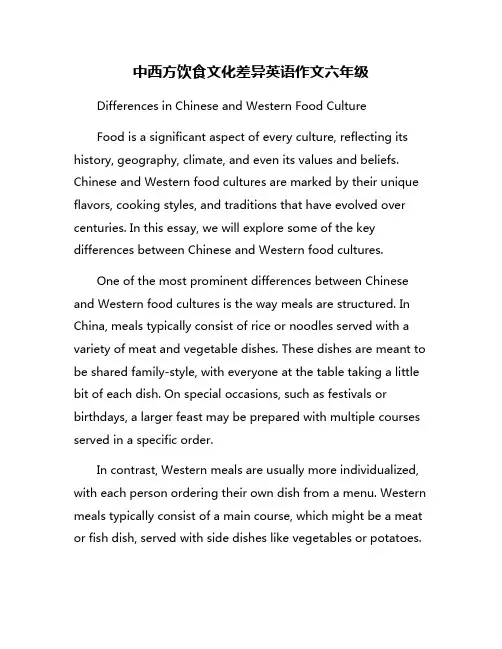
中西方饮食文化差异英语作文六年级Differences in Chinese and Western Food CultureFood is a significant aspect of every culture, reflecting its history, geography, climate, and even its values and beliefs. Chinese and Western food cultures are marked by their unique flavors, cooking styles, and traditions that have evolved over centuries. In this essay, we will explore some of the key differences between Chinese and Western food cultures.One of the most prominent differences between Chinese and Western food cultures is the way meals are structured. In China, meals typically consist of rice or noodles served with a variety of meat and vegetable dishes. These dishes are meant to be shared family-style, with everyone at the table taking a little bit of each dish. On special occasions, such as festivals or birthdays, a larger feast may be prepared with multiple courses served in a specific order.In contrast, Western meals are usually more individualized, with each person ordering their own dish from a menu. Western meals typically consist of a main course, which might be a meat or fish dish, served with side dishes like vegetables or potatoes.Dessert is often served at the end of the meal, and coffee or tea is offered as a drink.Another key difference between Chinese and Western food cultures is the use of ingredients and flavors. Chinese cuisine often features a wide variety of vegetables, herbs, and spices, resulting in bold and complex flavors. Garlic, ginger, soy sauce, and rice vinegar are commonly used to add depth and umami to dishes. Western cuisine, on the other hand, tends to focus on simpler flavors with less reliance on spices and condiments. Butter, cream, and cheese are common ingredients in Western cooking, adding richness and creaminess to dishes.Cooking methods also vary between Chinese and Western food cultures. Chinese cuisine often involves stir-frying, steaming, and braising, which require a high level of skill and precision to achieve the right texture and flavor. Western cuisine, on the other hand, includes techniques like roasting, baking, and grilling, which impart a different set of flavors and textures to dishes.Dining etiquette is another area where Chinese and Western food cultures differ. In China, it is customary to use chopsticks to eat, and slurping noodles or soup is seen as a sign of enjoyment. Sharing dishes is encouraged, and the host will often offer atoast to show hospitality. In the West, using a knife and fork is the norm, and it is considered polite to keep your elbows off the table and to chew with your mouth closed.Despite these differences, both Chinese and Western food cultures place a strong emphasis on the importance of food in bringing people together and fostering relationships. Whether it is a family gathering, a holiday celebration, or a formal banquet, sharing a meal is a way to show hospitality, respect, and appreciation for one another.In conclusion, the differences between Chinese and Western food cultures are a reflection of the diverse histories, geographies, and traditions of these two regions. Both cuisines have their own unique charms and flavors that have captivated people around the world. By understanding and appreciating the cultural nuances of each cuisine, we can gain a deeper appreciation for the role that food plays in our lives.。
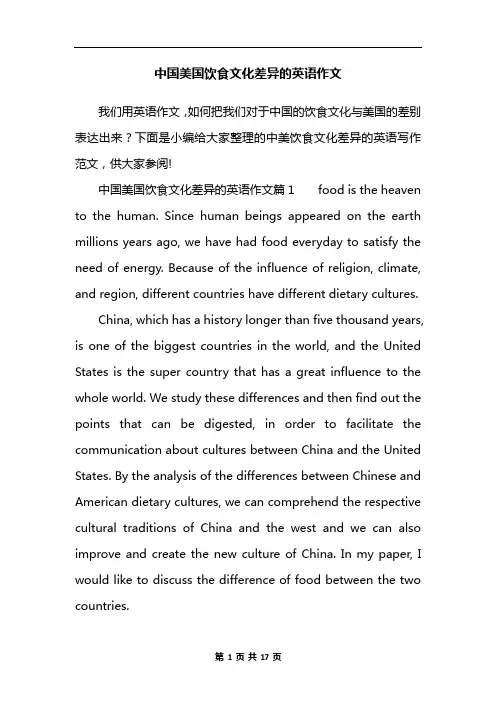
中国美国饮食文化差异的英语作文我们用英语作文,如何把我们对于中国的饮食文化与美国的差别表达出来?下面是小编给大家整理的中美饮食文化差异的英语写作范文,供大家参阅!中国美国饮食文化差异的英语作文篇1 food is the heaven to the human. Since human beings appeared on the earth millions years ago, we have had food everyday to satisfy the need of energy. Because of the influence of religion, climate, and region, different countries have different dietary cultures.China, which has a history longer than five thousand years, is one of the biggest countries in the world, and the United States is the super country that has a great influence to the whole world. We study these differences and then find out the points that can be digested, in order to facilitate the communication about cultures between China and the United States. By the analysis of the differences between Chinese and American dietary cultures, we can comprehend the respective cultural traditions of China and the west and we can also improve and create the new culture of China. In my paper, I would like to discuss the difference of food between the two countries.中国美国饮食文化差异的英语作文篇2 Hello , everyone we are very proud to introduce our topic . my name is huangxiaolong ,he is jiangzhihui ,he is lihuan .lets begin. Our topic is Differences Between Chinese And Western Food. cultural differences between East and West created a difference in food culture。
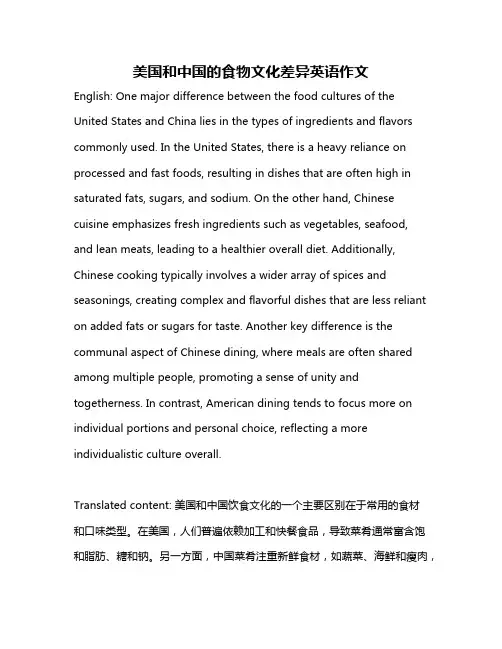
美国和中国的食物文化差异英语作文English: One major difference between the food cultures of the United States and China lies in the types of ingredients and flavors commonly used. In the United States, there is a heavy reliance on processed and fast foods, resulting in dishes that are often high in saturated fats, sugars, and sodium. On the other hand, Chinese cuisine emphasizes fresh ingredients such as vegetables, seafood,and lean meats, leading to a healthier overall diet. Additionally, Chinese cooking typically involves a wider array of spices and seasonings, creating complex and flavorful dishes that are less reliant on added fats or sugars for taste. Another key difference is the communal aspect of Chinese dining, where meals are often shared among multiple people, promoting a sense of unity and togetherness. In contrast, American dining tends to focus more on individual portions and personal choice, reflecting a more individualistic culture overall.Translated content: 美国和中国饮食文化的一个主要区别在于常用的食材和口味类型。
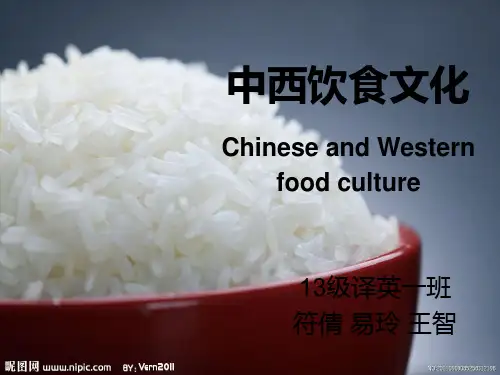
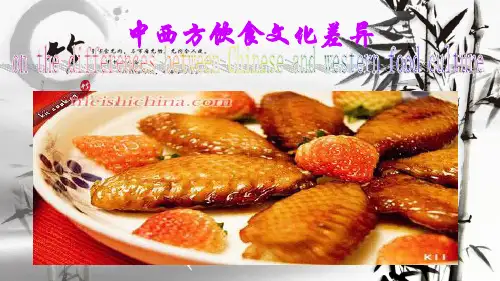
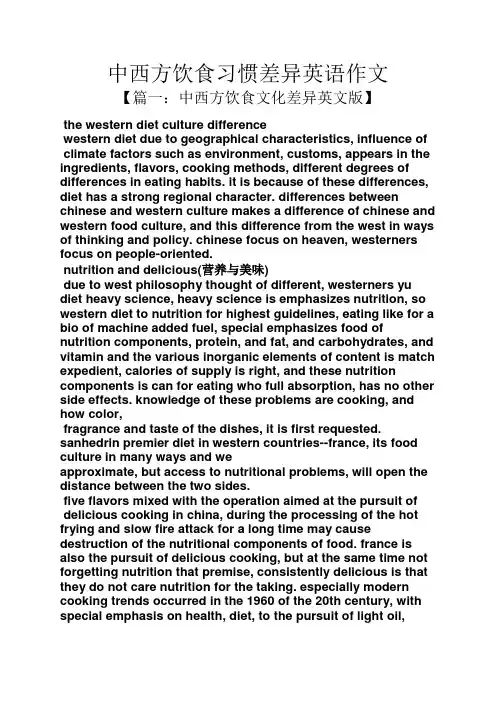
中西方饮食习惯差异英语作文【篇一:中西方饮食文化差异英文版】the western diet culture differencewestern diet due to geographical characteristics, influence of climate factors such as environment, customs, appears in the ingredients, flavors, cooking methods, different degrees of differences in eating habits. it is because of these differences, diet has a strong regional character. differences between chinese and western culture makes a difference of chinese and western food culture, and this difference from the west in ways of thinking and policy. chinese focus on heaven, westerners focus on people-oriented.nutrition and delicious(营养与美味)due to west philosophy thought of different, westerners yu diet heavy science, heavy science is emphasizes nutrition, so western diet to nutrition for highest guidelines, eating like for a bio of machine added fuel, special emphasizes food of nutrition components, protein, and fat, and carbohydrates, and vitamin and the various inorganic elements of content is match expedient, calories of supply is right, and these nutrition components is can for eating who full absorption, has no other side effects. knowledge of these problems are cooking, and how color,fragrance and taste of the dishes, it is first requested. sanhedrin premier diet in western countries--france, its food culture in many ways and weapproximate, but access to nutritional problems, will open the distance between the two sides.five flavors mixed with the operation aimed at the pursuit ofdelicious cooking in china, during the processing of the hot frying and slow fire attack for a long time may cause destruction of the nutritional components of food. france is also the pursuit of delicious cooking, but at the same time not forgetting nutrition that premise, consistently delicious is that they do not care nutrition for the taking. especially modern cooking trends occurred in the 1960 of the 20th century, with special emphasis on health, diet, to the pursuit of light oil,emphasized the use of fresh raw materials, stressed during the cooking process tomaintain original nutrition and taste, so vegetables are eaten raw. so that the western diet nutrition is universal。
English Version: Differences in Food Culture Between China and the West The culinary landscapes of China and the West are vast and diverse, each reflecting the rich histories, traditions, and lifestyles of their respective cultures. These differences extend beyond mere ingredients and cooking techniques; they encompass a deep-seated understanding of food as a means of communication, celebration, and nourishment. In this essay, we will explore some of the most notable distinctions between Chinese and Western food cultures.1. Ingredients and FlavorsChinese cuisine is renowned for its variety of ingredients and intricate flavor profiles. Fresh vegetables, meats, seafood, and a wide array of spices and herbs are used to create dishes that are often bold, complex, and harmonious in taste. Contrastingly, Western cuisine, while equally diverse, tends to emphasize meat and dairy products as the foundation of many dishes. Flavors are often more straightforward, with a focus on balancing sweet, sour, salty, and bitter tastes. 2. Cooking TechniquesChinese cooking employs a myriad of techniques, from stir-frying and steaming to braising and deep-frying. These methods are designed to preserve the natural flavors and textures of ingredients while enhancing their overall appeal. Western cuisine, on the other hand, favors techniques such as baking, grilling, and roasting, which often result in dishes with a distinct crust or exterior texture.3. Meal StructureIn China, meals are typically structured around a main dish, often accompanied by a variety of side dishes, soups, and rice or noodles. This approach emphasizes balance and variety within a single meal. Western meals, however, tend to follow a more structured course system, with appetizers, main courses, and desserts served sequentially. This sequence allows for a more deliberate progression of flavors and textures throughout the dining experience.4. Dining CustomsDining customs in China often involve communal eating, where dishes are shared among diners. This practice fosters a sense of camaraderie and encourages conversation. In contrast, Western dining customs often involve individual plates and utensils, reflecting a greater emphasis on personal space and privacy during meals.5. Role of Food in CultureFood plays a central role in both Chinese and Western cultures, but its significance differs. In China, food is often seen as a means of expressing hospitality, respect, and affection. It is a fundamental aspect of social gatherings and celebrations, where the quality and variety of dishes served reflect the importance of the occasion. In Western cultures, food is also valued, but its role in social interactions may be more nuanced. It is often used to mark specialoccasions, but daily meals are not necessarily imbued with the same level of cultural significance.Chinese Translation: 中西方饮食文化的差异中西方饮食文化各具特色,反映了各自丰富的历史、传统和生活方式。
Differences in Chinese and Western Food Cultures (英语作文) The vast tapestry of global cultures is woven with intricate threads of tradition, and nowhere is this more evident than in the diverse landscapes of culinary arts. Chinese and Western food cultures, each steeped in rich histories and distinct customs, offer a fascinating contrast that illuminates the profound differences between East and West.Firstly, the emphasis on mealtime rituals and social gatherings sets these two cultures apart. In China, dining is often a communal affair, where family and friends gather around a table laden with an array of delicacies, each dish meticulously prepared to showcase the chef's culinary prowess. Conversations flow freely, and the act of sharing food symbolizes unity and harmony. In contrast, Western dining culture tends to be more individualistic, with plated meals served to each diner. Mealtimes, while still social occasions, often revolve around smaller gatherings and more focused conversations.Secondly, the use of ingredients and cooking techniques varies greatly. Chinese cuisine is renowned for its use of a wide variety of fresh ingredients, including meats, seafood, vegetables, herbs, and spices. Techniques such as stir-frying, steaming, braising, and deep-frying are employed to bring out the natural flavors and textures of these ingredients. Western cuisine, on the other hand, while also diverse, tends to rely more heavily on dairy products, grains, and meats, with a focus on baking, roasting, grilling, and sautéing as primary cooking methods.Furthermore, the concept of balance and harmony plays a pivotal role in Chinese cuisine. The Five Flavors (sweet, sour, bitter, spicy, and salty) and the Four Seasons (with their corresponding ingredients) are carefully considered to create dishes that are not only delicious but also believed to promote health and well-being. Western cuisine, while also striving for flavor balance, does not adhere to such a strict philosophical framework.Lastly, the role of dining in daily life differs. In China, meals are often seen as opportunities for relaxation and bonding, with breakfast, lunch, and dinner each carrying their own significance and rituals. Western cultures, however, tend to prioritize efficiency and convenience, with fast food and take-out options becoming increasingly popular. This has led to a shift in dining habits, where meals are sometimes consumed on-the-go or in front of screens.中文翻译:全球文化的广阔画卷由传统这一错综复杂的丝线编织而成,而在烹饪艺术的多样景观中,这一点尤为明显。
中西饮食文化差异英语作文The Difference between Chinese and Western Food Culture。
Food culture is an important part of a country's culture. It reflects the history, geography, customs and habits of a nation. Chinese and Western food culture aretwo of the most representative food cultures in the world. Although they have their own unique features, they alsohave some differences.Firstly, the cooking methods are different. Chinese cuisine emphasizes the use of heat, such as stir-frying, steaming, and boiling. The goal is to preserve the original flavor and nutrients of the ingredients. On the other hand, Western cuisine often uses baking, grilling, and roastingto bring out the natural flavors of the food and add a smoky or charred taste.Secondly, the ingredients used in Chinese and Western cuisine are also different. Chinese cuisine often uses avariety of vegetables, such as bok choy, Chinese cabbage, and bamboo shoots, as well as seafood and poultry. Western cuisine, on the other hand, often uses a lot of meat, such as beef, pork, and lamb, as well as dairy products like cheese and butter.Furthermore, the dining etiquette is different. In China, it is common for people to share dishes and use chopsticks to eat. It is also considered polite to leave some food on the plate to show that the host has provided more than enough. In Western culture, each person has their own plate and utensils, and it is considered rude to leave food on the plate.In addition, the way of dining is also different. In China, people often eat together with their family or friends, and the dishes are placed in the center of the table for everyone to share. In Western countries, people often eat in a more formal setting, with each person having their own plate of food.Moreover, the cultural significance of food isdifferent. In China, food is often used to celebrate festivals, weddings, and other important occasions. Many Chinese dishes have symbolic meanings, such as fish symbolizing abundance and prosperity. In Western culture, food is often used to celebrate holidays and special occasions, and certain foods are associated with specific events, such as turkey for Thanksgiving and chocolate eggs for Easter.In conclusion, Chinese and Western food culture have their own unique features and differences. Understanding and appreciating these differences can help people from different cultures to better understand and respect each other. Food is not only a source of nourishment, but also a reflection of a country's history, traditions, and values.。